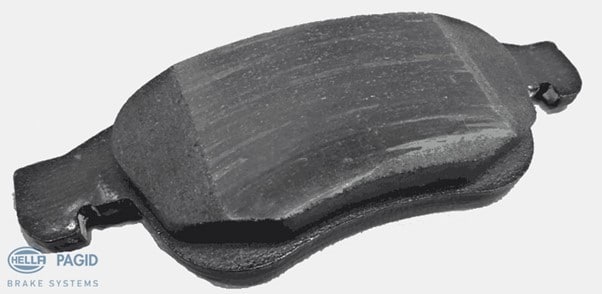Most motorists will not deal with the brake system in their vehicle until the first problems occur. It is one of the vehicle components that is very difficult to inspect externally and to which attention is only paid when the warning light in the dashboard lights up or the braking power of the vehicle decreases.
Yet the brake system is one of the most important components of a vehicle and should also be inspected with particular attention whenever you go for inspection and maintenance in specialist workshops. A fault in the brake system can have catastrophic consequences. For this reason, you should also have the necessary basic knowledge to be able to check the condition of the system and understand the functions of the individual components.
We would also like to point out that work on the brake system should only be carried out by specialized workshops. Nevertheless it’s good to be familiar with the most important components of the brake system in order to prevent malfunctions.
The 3 Most Important Components of a Vehicle’s Brake System
The task of the brake system is to decelerate the speed of a motor vehicle in the shortest possible time. The friction of the brake pads on the brake disc converts the braking energy into thermal energy. This generates high forces and high temperatures, and also places great stress on the individual components of the braking system. The good condition of all parts of the brake system is therefore very important to ensure a good and safe effect. We would like to take a closer look at the individual components of the brake system, all of which are crucial for proper functioning.
1. The Brake Fluid
The brake fluid performs an important task in modern brake systems. The hydraulic fluid ensures that the force from the brake pedal is transmitted to the brake caliper and then to the brake pads. During the braking process, the brake fluid builds up the force through the brake pedal via the brake booster, brake lines and hoses to the brake pads in the brake caliper. This can create a pressure of up to 150 bar, causing the brake fluid to heat up considerably.
However, this is not the only task of the brake fluid. It must also protect against corrosion of the metallic components and must not attack the seals. For this reason, only a high-performance brake fluid can ensure that the driver has optimum control of their car and can move safely in traffic.
What should you look for in brake fluid:
Brake Fluid Level
The reservoir ensures that there is enough brake fluid at all times. As the brake pads wear, the pistons in the caliper must move out further and more brake fluid is needed in the system. This can cause the level in the reservoir to become lower, but it should never fall below the minimum level.
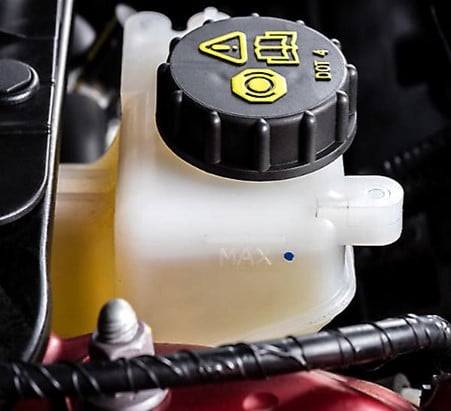
When the brake pads have been replaced with new ones, the level in the reservoir may rise again, but should never rise above the Max mark.
Topping up Brake Fluid
Normally it is not necessary to top up brake fluid since the level has dropped below the MIN mark, you should have the entire system checked at a specialist workshop. Leaky brake lines or defective seals can lead to a loss of brake fluid.
If there are no faults or in an emergency, you can top up the brake fluid. You should generally use the type of brake fluid that has been approved by the manufacturer. This is usually indicated by the DOT number on the cap of the reservoir and also mentioned in the manual.
DOT is the abbreviation for the United States Department of Transportation, which has defined minimum requirements for brake fluids in FMVSS Standard 116. The higher the DOT number, the higher the requirements the brake fluid must meet. Even though it is generally possible to mix DOT-3, DOT-4 and DOT-5.1 brake fluids, the grade that is also recommended by the manufacturer should always be selected. An exception is the brake fluid DOT-5. It is made on a silicone base and must not be mixed with any other brake fluid.
Age of the Brake Fluid
Brake fluid in a passenger car is exposed to extreme pressure and temperature differences. Over a longer period, this can cause it to lose its important properties. One reason for this is the hygroscopic property of brake fluid, which means that it absorbs water. This can be triggered by the humidity in the air and lead to corrosion in the brake system.
However, water in brake fluid leads to more problems than just corrosion. Water has a lower boiling point than brake fluid, which can cause bubbles to form in the brake system at the high temperatures. Under normal circumstances, these bubbles are directed out through the expansion tank, but they can also cause brake pressure to drop and even cause the brake pedal to “drop out.” In extreme cases, the driver can then push the brake pedal all the way to the floor without achieving the necessary braking power.
If too much water accumulates in a brake system, there is also a risk that the water will freeze in winter and disable the entire brake system.
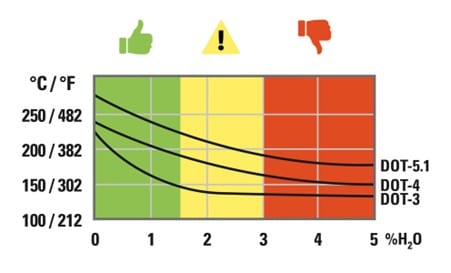
The older the brake fluid, the more water it absorbs. From a water content of 3%, the brake fluid can no longer guarantee its function and this can lead to a total failure of the brake system.
Viscosity and Boiling Point
The viscosity and boiling point of brake fluid are decisive factors in ensuring correct functioning of the brake system. Both can decrease with age.
Viscosity is a measure of the resistance of a liquid substance to a change in shape. The higher the viscosity, the more viscous or less flowable a substance is. The viscosity of the brake system is very important for the brake system. It has to be pressed through many small holes and lines. This becomes more difficult the more viscous it is.
The boiling point is also important. The high pressure in the brake system creates high temperatures. This can cause the brake fluid to boil and not build up brake pressure.
The boiling point of brake fluid is measured in two different ways. The dry boiling point and the wet boiling point.
Type Dry boiling point in °C Wet boiling point in °C Viscosity in mm2/sec
DOT 3 205 140 1.5
DOT 4 230 155 1.8
DOT 5.1 260 180 900
A brake fluid reaches the dry boiling point only when it is new and still sealed in the original container. The wet boiling point can then be checked at a specialist workshop for used brake fluid.
Brake Fluid Maintenance and Inspection
The brake fluid is exposed to extreme temperature fluctuations and pressures during operation. Since it is crucial for the brake system that the brake fluid is in good condition, it should be maintained and changed regularly.
In specialized workshops, the water content and boiling point can be tested to check the current condition of the brake fluid.
2. The Brake Discs
The brake discs are among the most important components of the brake system. They are responsible for generating enough frictional force for the vehicle to brake. To do this, hydraulic pressure from the brake pedal is transmitted through the brake lines to the brake cylinders in the brake shoes. There, the brake pads then press on the brake disc and generate a mechanical contact pressure.
Brake discs are considered wear parts, even though they do not need to be replaced as often as the brake pads. The brake discs are made of steel alloys because they are exposed to high loads and temperatures. Since a good condition of the brake discs is crucial for sufficient braking power, they must be checked at appropriate intervals.
Wear and Tear of Brake Discs
The mechanical stress on the brake discs causes them to close up, which makes them thinner. The vehicle manufacturers specify a minimum thickness, which should not be fallen short of under any circumstances. In order to measure the degree of wear, the wheels and usually some brake parts must be removed. For this reason, the measurement of the thickness of the brake disc should be done exclusively in specialized workshops.
It is advisable to carry out the thickness of the brake disc every time the brake pads are changed. If the brake discs on a used car need to be checked, however, a visual inspection can also provide information on the approximate wear. The abrasion of the brake pads creates a grade at the edges of the brake disc.
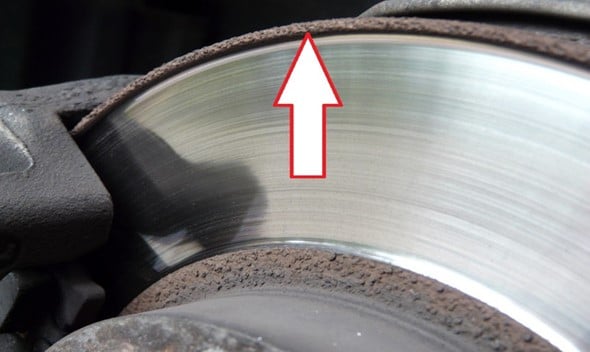
The higher and more pronounced the degree, the more likely it is that the brake disc will have to be replaced. The visual inspection can also be carried out with the wheels mounted, but should only ever be used as a guide, as the current degree of wear can only be accurately determined by measurement. The brake disc in the picture above shows a high degree of wear and should be replaced quickly.
Signs of Overheating and Overstressing
During each braking operation, the brake disc is heated by the friction of the brake pads. Under normal conditions, heating of the brake disc should not be a problem because it is cooled again by the airstream. However, under extreme conditions, for example due to heavy braking from high speeds or long downhill runs, severe heating can occur. Since the brake disc is made of heat-treated steel, extreme overheating can change the properties of the material. In addition, extreme overheating followed by rapid cooling can cause the brake disc to change shape. Consequences can then be jammed or stuck brake pads, defects in the brake pistons of the brake calipers, and even just rapid wear of the brake discs.
Extreme overheating of the brake discs can also be detected during a visual inspection.
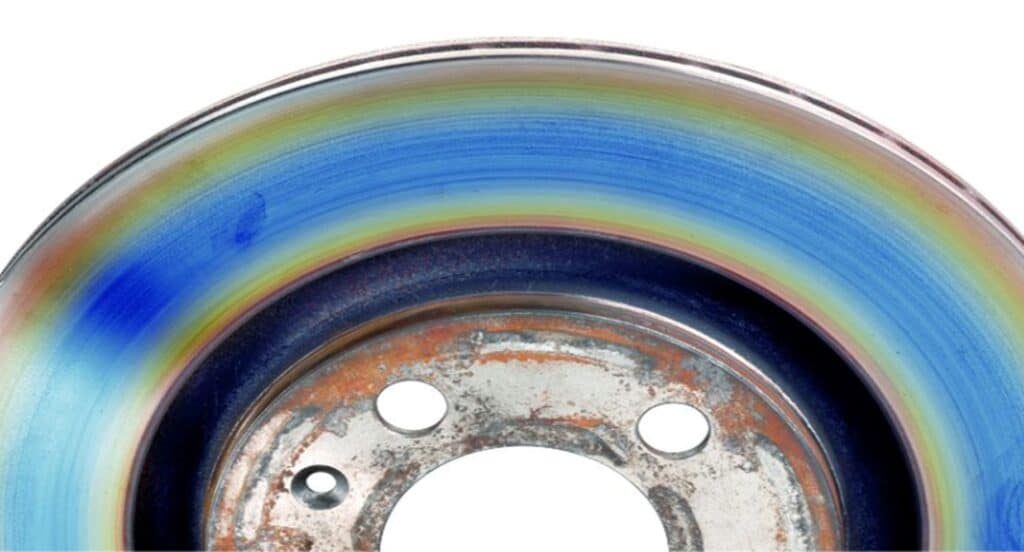
Due to the extreme temperature change, the surface of the brake disc changes to a bluish to reddish color. As the next picture shows, a color change does not have to extend over the entire brake disc.
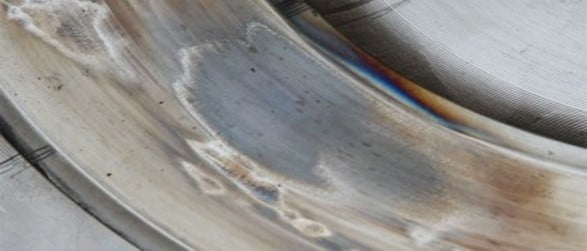
Overheated brake discs must be replaced in any case, as they represent a high safety risk. Since the material of the brake disc can lose its properties and warp due to high overheating, there is a high probability that normal braking and steering can no longer be guaranteed.
Visual Inspection of the Brake Disc – Scoring and Grooves
Another negative defect pattern that can be detected during the visual inspection of brake discs can be grooves and scores on the bearing surface. They are caused by uneven wear of the brake disc, which usually also indicates problems with the brake pads. These can also become overheated and “glaze”. This creates a hard surface on the brake pads, which leads to a reduction in braking power.
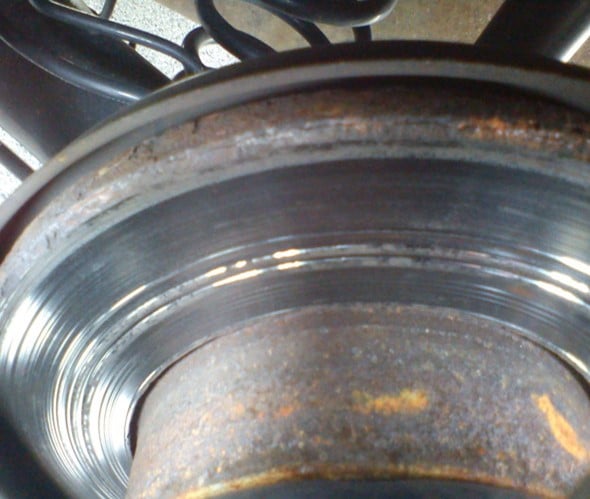
If grooves or scores are found on the brake discs, the vehicle should be inspected at a specialist workshop.
Visual Inspection of the Brake Disc – Cracks
Cracks in the disc brake can have various causes. Usually, they indicate mechanical overstress or quality problems. They represent a serious safety risk and the vehicle should definitely no longer be used on the road. To fix the problem, the brake discs and the brake pads must be replaced.
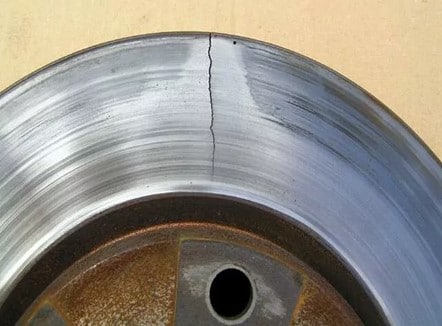
Visual Inspection of the Brake Disc – Corrosion
Corrosion is a common problem with brake discs. Since they are also exposed to rain and other external influences due to the cooling they require, rust can easily develop. If the vehicle is moved enough, the brake pads ensure that no corrosion can occur on the surfaces of the brake disc during each braking operation. However, if the vehicle is left unused for a long period of time or is only used on very short trips where the brakes are used very little, rust can build up on the brake disc.
If, when visually inspecting a brake disc, you find that the entire brake disc is rusted, the braking performance should be checked by a specialist workshop. In most cases, at the very least, a thorough cleaning is then required and, in some circumstances, a replacement of the brake disc and brake pads. Vehicles with corrected brake discs should only be moved very carefully, as the corrosion results in reduced braking performance.
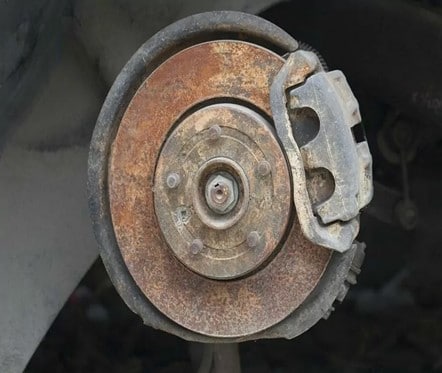
3. Brake Pads
Brake pads, with the cooperation of the brake disc, have the task of converting kinetic energy into heat and friction and thus triggering a reduction in speed. They are often subject to extreme loads and therefore require particular attention.
Brake pads consist of various abrasive metals, resins and other binders. In some high-performance sports cars, carbon fiber materials are also used. They are bonded to a backing plate so that they can be held in position in the brake shoes.
Brake pads are designed as wear parts so that they achieve the highest possible braking performance but cause the least possible wear on the brake discs. They wear over time and must be replaced when they reach their minimum pad thickness.
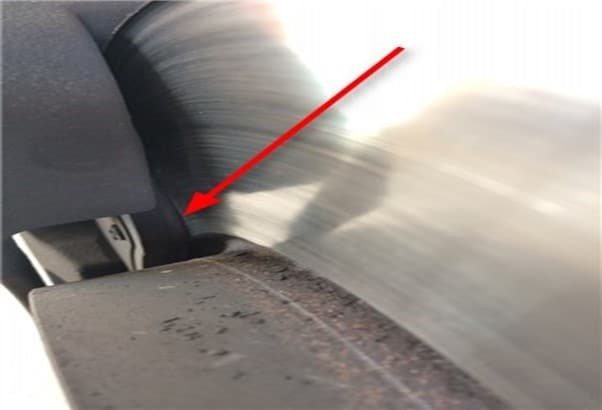
A visual inspection can reveal how much brake lining is still present. Most car manufacturers stipulate that brake pads must be replaced before a pad thickness of 4 mm has been reached. However, it should be avoided at all costs that the backing plate comes into contact with the brake disc. Apart from a very reduced braking performance, this can also lead to serious damage to the brake disc. Early replacement of the brake pads is therefore advisable in any case.
Overheating and Overstressing of Brake Pads
Just like the brake disc, brake pads are sometimes subjected to high stresses. Since the actual surface of the brake pads cannot be checked once they are installed, other factors may indicate overheating or stress. For example, if the brake disc shows signs of translation, the brake pads should definitely be replaced as well.
Another important indication of overuse of the brake pads is reduced braking force. This is usually caused by a “glazed” surface of the brake pads. It occurs when the brake pads are exposed to extreme temperatures. Just as with brake disc overheating, this can be triggered by frequent braking from high speeds or long downhill runs. Mechanical problems in the brake shoes can also cause brake pads to overheat. In this case, the cylinders in the brake shoes, which are responsible for the contact pressure, can no longer retract completely. This results in constant contact pressure, which causes the brake pads to overheat. If it is found that overheating has occurred when the brake pads are replaced, it is recommended that the entire brake system be checked. Since the replacement of brake pads is one of the most common jobs in garages, the costs are usually low.
